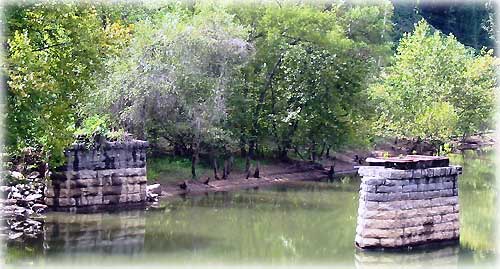 By Bob Ciminel January 17, 2006
My wife has been a Realtor in the Atlanta area for the past nine years, and at one time I considered applying for a real estate license and becoming her assistant. However, I knew it would never work out - being her assistant, I mean. After almost 35 years of marriage, I know how Alice works. Our work ethics are pretty incompatible, which is why I'm really good with technical stuff and she's really good with people. Alice was a teacher in her prior life; I was a sailor - 'nuff said? I pulled out my real estate course textbook, "Real Estate Dynamics," which would not be the operative description for many of the agents Alice has worked with, and looked up the chapter on eminent domain. I sure hope the Supreme Court used a better reference document as the basis for their decision.  Photograph by Bob Ciminel 2004.
Well, there's the rub. Just what is "just compensation?" When you read our country's laws and regulation, you quickly learn there are too many adjectives and adverbs. The word "just" can mean in the immediate past, at this moment, only, barely, or exactly; as an adjective, "just" can mean fair and impartial, morally correct, or reasonable. Eminent domain came into play in a big way during the 1800s when the country was undergoing rapid growth of its rail system. How could a railroad, a private corporation, reasonably acquire rights-of-way through farms and towns without being held hostage by owners unwilling to sell a swath of land 25-feet wide through their property? Even though a railroad was privately owned, it obviously provided a public service by hauling passengers, goods, and mail from Point A to Point B. And that leads to an interesting story. In 1888, the Marietta and North
Georgia Railroad was about to complete its railroad between Marietta,
Georgia and Murphy, North Carolina, a project that was vital
to providing passenger and freight service to the people living
in the North Georgia mountains, who were virtually isolated from
the major population centers by the mountains and rivers of the
lower Appalachians. Unfortunately, the track ended about a half-mile
short of its final destination, a depot on the north bank of
the Hiwassee River, because the M&NG had not secured a right-of-way
through the Hitchcock property on the south bank of the river. A little investigation revealed that another railroad had reached Murphy before the M&NG and took out options to tie up property it knew the M&NG would need before it could build its line across the Hiwassee and into Murphy. The spoiler incorporated as the Chattanooga, Cleveland, and Murphy Railway in 1888. It never laid a foot of track, but kept the M&NG and its successors out of Murphy for eight years while making a fortune in profits selling its land options to the M&NG. The Hitchcock family received their critical piece of property along the Hiwassee as a wedding gift in 1839. However, by the time the M&NG came along, the Hitchcocks were residents of San Francisco. The surviving owner was Lillie Hitchcock, who eventually became Mrs. Howard B. Coit, and the namesake of San Francisco's famous Coit Tower atop Telegraph Hill. The "Murphy road block" was not corrected until the M&NG was merged into the Atlanta, Knoxville and Northern Railroad. By that time the line to Murphy had been reduced to branch line status and a new main line was built to Knoxville, Tennessee through the copper mining area of Ducktown. In 1897, the AK&N petitioned the Superior Court of Murphy, NC to condemn the Hitchcock property, which was still deeded to Martha Hitchcock, Lillie's deceased mother. All the AK&N wanted was the right to traverse the property and extend its track into Murphy. Three years later a five-man commission appraised the property at $169.25 and awarded it to the railroad after compensation was paid to Lillie Coit. The Murphy Branch operated
until the late 1980s when it was abandoned by CSX Corporation.
The rails were torn up and the bridges removed, but you can still
see the piers for the bridge across the Hiwassee River. The former
Hitchcock property is the new home for one of Murphy's fire stations,
a fitting memorial to Lillie, who was famous for her support
of San Francisco's volunteer firemen. He assumes informed readers will be able to tell the difference. ciminel@sitnews.us
|